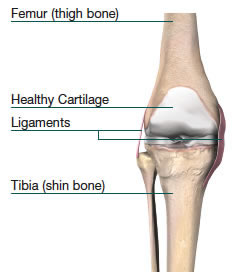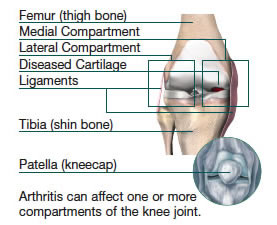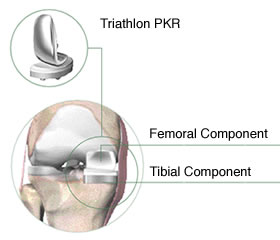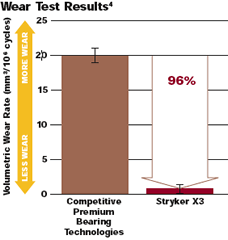Partial Knee Resurfacing

Arthritis pain affects more than 40 million Americans.1 If you’re reading this website, you may be one of them. There are many causes of knee pain and there are a variety of treatment options. This website will review the causes and treatments of knee pain, highlighting more conservative knee treatment. Alleviating the pain and restoring mobility in your knee may allow you to do the simple things — from walking to gardening, even playing with your grandchildren, and most importantly, just enjoying life again. Information is the first step toward potential relief from joint pain.
Knee Anatomy and Function
The knee is the largest joint in the body and is central to nearly every routine activity. The knee joint is formed by the ends of 3 bones: the lower end of the thigh bone (femur), the upper end of the shin bone (tibia), and the knee cap (patella). Thick, tough tissue bands called ligaments connect the bones and stabilize the joint. A smooth, plastic-like lining called cartilage covers the ends of the bones and prevents them from rubbing against each other, allowing for flexible and nearly frictionless movement. Cartilage also serves as a shock absorber, cushioning the bones from the forces between them. Finally, a soft tissue called synovium lines the joint and produces a lubricating fluid that reduces friction and wear.
What Causes My Joint Pain?
Normally, all of the parts of the knee joint work together and the joint moves easily and without pain. However, diseases or injury can disturb the normal functioning of the joint resulting in:
- Pain
- Muscle weakness
- Limited movement
Osteoarthritis (OA)
One of the most common causes of knee pain and loss of mobility is the wearing away of the joint’s cartilage lining. When this happens, the bones rub against each other, causing significant pain and swelling — a condition known as osteoarthritis. Trauma or direct injury to the knee can also cause osteoarthritis. Additionally, without cartilage there is no shock absorption between the bones in the joint, allowing stress to build up in the bones and contributing to pain.
Osteoarthritis is probably the most common joint disorder in the United States, affecting approximately 20 million people.1
Treatment Options for Arthritis
Following an orthopaedic evaluation, your orthopaedic specialist will review and discuss the results with you. Your treatment options may include:
- Medication
- Physical therapy
- Knee joint fluid supplements
- Arthroscopy
- Knee joint resurfacing
If non-invasive treatment options are not giving you satisfactory pain relief, knee surgery may become necessary. However, a total knee replacement (TKR) may not be necessary — alternate types of knee implants are available.

Partial Knee Resurfacing (PKR)
There are three compartments to the knee: the medial (inside) compartment, the lateral (outside) compartment and the patellofemoral (kneecap) compartment. Depending on where the arthritis affects your knee, partial knee resurfacing may be an option for you. PKR is a growing procedure. There are approximately 70,000 partial knee resurfacing procedures done in the U.S. each year.2
Partial knee resurfacing (PKR) is a surgical procedure for relieving arthritis in one compartment of the knee. With PKR, only the damaged surface of the knee joint is replaced,helping to minimize trauma to healthy bone and tissue. The surgeon removes only damaged bone in the affected knee and fits the implant to that bone. Because the PKR artificial joints are smaller than total knee implants, the surgical incision may be smaller as well.
Since most of the knee joint is unaffected and the basic knee structure remains intact, post-operative pain may be reduced and the recovery period may be shorter than total knee replacement.3

Triathlon® Partial Knee Resurfacing
Triathlon® PKR was developed with patient needs in mind. The implant is anatomically shaped and helps enable surgeons to use the latest minimally invasive surgical techniques. With this procedure, only the affected compartment of the arthritic femur and the tibia are resurfaced with artificial implants.
Potential Benefits of PKR

X3® Technology
The bearing surface is defined as the two parts of the knee implant that glide together throughout motion. Triathlon® PKR utilizes Stryker’s advanced bearing technology, called X3®, which has demonstrated up to 96% decrease in wear in laboratory testing compared to competitive premium bearing surfaces in TKRs.4 Triathlon® PKR is the only unicompartmental knee with this technology.
Quicker Recovery
Because the PKR artificial joints are smaller than total knee implants, the surgical incision may be smaller. A smaller incision may lead to a smaller scar. Other potential benefits to PKR include a quicker operation and a shorter hospital stay compared to a total knee replacement.3 Rehabilitation may also be more progressive.3 Because less bone is removed and there is less trauma to soft tissue during surgery, your knee may feel more natural than with a total knee replacement.3
Not all patients are candidates for Partial Knee Resurfacing. Depending on your condition, a total knee replacement may be recommended by your doctor.

Total Knee Replacement
Total Knee Replacement (TKR) may be necessary if more than one compartment of your knee is arthritic. In TKR, your surgeon will replace all 3 compartments of your knee using total knee components.
Risks Associated with PKR/TKR
As with any surgery, there is a risk of complications. Blood clots are the most common complication after surgery. Your doctor may prescribe one or more measures to help prevent blood clots from forming in your leg veins, such as special support hose and blood thinners. You may also receive antibiotics to help prevent infection. Your doctor can provide you with more information about other potential risks.
Risk factors relating to your anatomy, weight, prior joint surgeries and your personal health should also be addressed with your doctor.
You Don’t Have to Live with Severe Joint Pain
You don’t have to live with joint pain and the limitations it puts on your activities. Partial knee resurfacing with X3® technology may relieve your pain and restore the function in your knee. Talk to your doctor today about the treatment options that may provide the pain relief you long for and help enable you to return to your favorite activities.
Click here to see our videos
